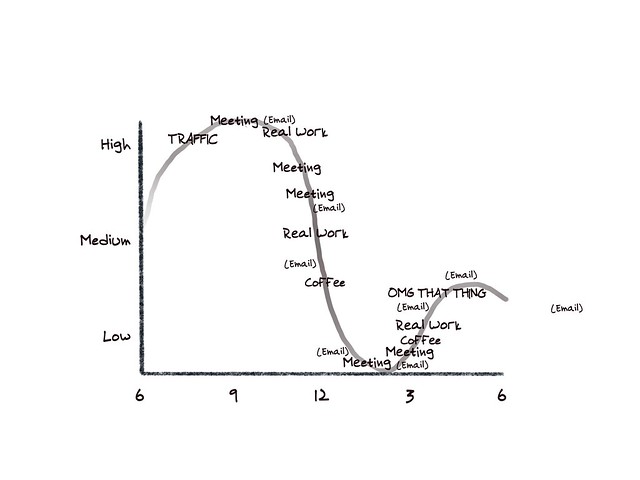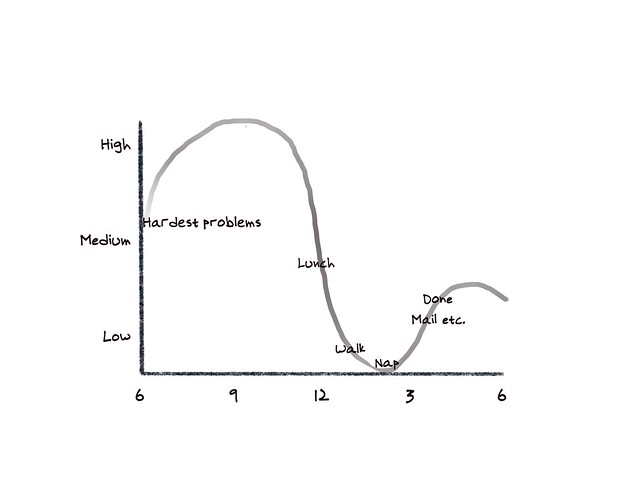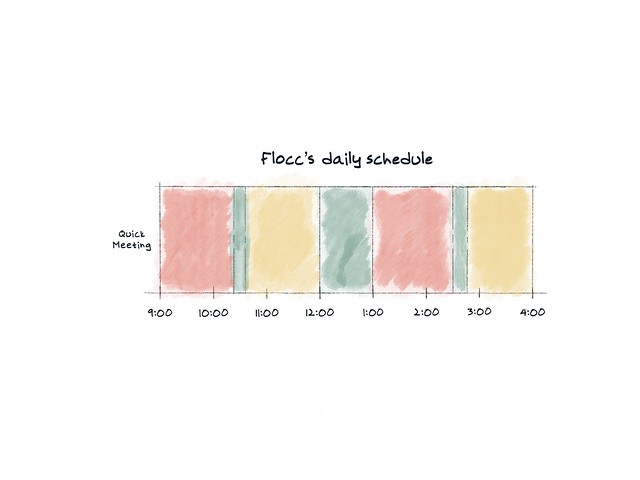Anja Svetina Nabergoj, a design thinking and creativity researcher based in Slovenia, writes about how a better understanding your chronotype and help you design better work routines:
If you want to maximize your deep work and be effective in your creative practice, you need to work in sync with your chronotype….
Prime time is a short window when our energy levels are highest and you are most primed to focus on demanding tasks…. Prime time is the time when it is best to focus on converging. Focusing on one thing and going deep. There is a myth that we need a lot of time (like 6-hour blocks) to create something new. And when we don’t have that luxury of time, most of us don’t even try to work on complex and demanding tasks. In reality, our prime time is usually much shorter — only around 90 minutes — and if you can block that time in your calendar a few days each week, you can create incredible progress.
This is what the Nobel laureates and other super-creative people I write about in REST figured out.
Creating routines that let them do their most challenging and important work when they were at their creative peak would let them be a lot more productive, have better ideas, and live more sustainable creative lives than if they ground metal for 12 hours a day.
If you think about a normal work day, it often looks something like this.
Different kinds of tasks are scattered through the day. Every hour is treated as equivalent to every other hour; it doesn’t acknowledge that there are times when we’re at peak energy and attention, and times when we’re low-energy. (Meetings after lunch? Who thinks this is a good idea?) Some of our highest-energy time is spent fighting traffic. Email checks are scattered throughout the day. And if you want to do more work, you stretch out the work day, coming in early and staying late.
In contrast, the people I write about in REST have days that look more like this.
They tend to start a lot earlier. The hardest work happens first, in a burst of 4-5 hours, often with a break in between, and is pretty much done before lunch. They have far fewer distractions, by design: even if you don’t move to the country to reduce the number of callers and visitors (and Charles Darwin did), you purposely ignore email, Slack, etc. during your energetic peak and “deep work” time. When you’re at a low, you stop: you eat, go for a walk, have a nap, then do a bit more in the afternoon, and probably set things up for the next day. Then you’re done.
The big point here that success in this model isn’t about piling in more things, doing more multitasking, and making the days longer. Success depends on doing your most important work at the time when you’re best able to focus on it, and refusing anything that dilutes that time. You don’t stretch out the day, you make the peak higher.
Or, as Nabergoj puts it in a second piece,
Once you know your energy curve, you can derive WHEN to do WHAT. Seek alignment between what your brain is best primed to do at any given time and the task you will engage in. Prime time, which is the highest peak in our energy curve, is supposed to be the time when we are best equipped to do demanding mental work….
On the other hand down times, when you are lowest in energy, are the times when your brain is less vigilant and you have fewer inhibitions, which makes it easier for abstract ideas to form….
Knowing your energy curve can help you design your schedule in a way that works in sync with your inner clock and most importantly, will help you determine your prime time and protect it to engage in deep work.
Okay, you say, that’s cool if you’re independently wealthy or whatever. What about the rest of us?
Few of us have the independence to design our workdays. That’s why, as I argue in SHORTER, we need companies to redesign their routines.
Companies that successfully make the transition to 4-day weeks don’t just chop a day off the calendar; they redesign their workdays, to give everyone tie for deep work. For example, this is the schedule developed by Norwich, England-based firm flocc:
After a short meeting to plot out the day’s work, they break the day up into three times: red time, which is for quiet, deep work or solo thinking; amber time, which is for client meetings, collaborative work, and other stuff that’s a bit noisier or requires less focus; and green time, which is coffee breaks and lunch.
It’s not optimized for any single person’s chronotype, but it probably overlaps with enough people’s to be useful, and the discipline of having a collective daily routine in which everyone agrees on when you’re heads-down and when you talk about who’s in danger of relegation, provides pretty serious gains.
Flocc is unusual in spelling it out so clearly, but just about every company I study does some version of this. It might be just a couple hours per week, or it can be daily; but they all think about how to design their days to give people more time to do their essential work.
The point is, understanding your chronotype is great, and harnessing it can have tremendous benefits. But to do that really effectively, you need to be in an environment– or an organization– where you can apply that knowledge.




